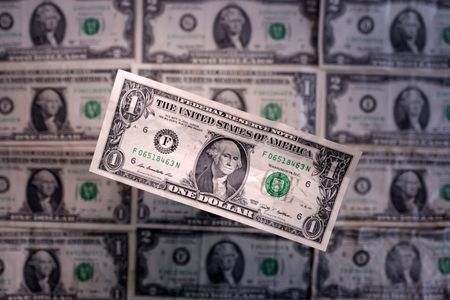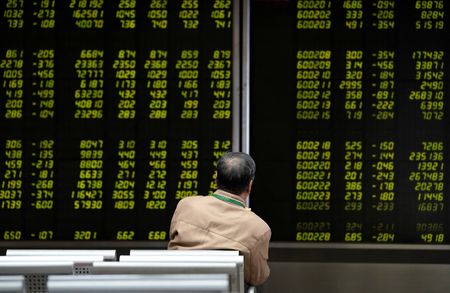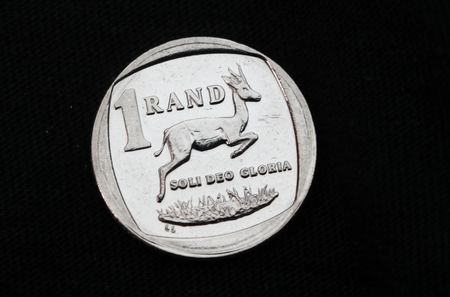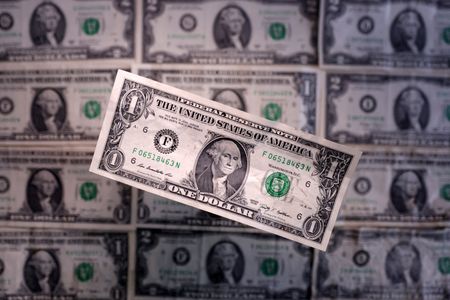By Kevin Buckland and Jaspreet Kalra
TOKYO (Reuters) – The U.S. dollar was choppy on Thursday as traders parsed the Federal Reserve’s measured stance on further interest rate cuts, while focus also turned to the Bank of England’s scheduled policy decision, with no change on rates expected.
Sterling was down 0.1% at $1.3615 after briefly leaping to the highest since July 2 at $1.3726 in the prior session.
The euro was steady at $1.1823, after retreating from its highest level since June 2021 at $1.19185 on Wednesday in a knee-jerk reaction to the Fed announcement.
The Fed reduced rates by a quarter point on Wednesday, as expected, with Chair Jerome Powell characterizing the day’s policy action as a risk-management cut in response to the weakening labour market, but said the central bank did not need to rush easing.
Analysts differed over the signals sent by the Fed. While those at Goldman Sachs said that many hints had pointed to Wednesday’s cut being the first among many, their counterparts at ANZ characterized the Fed Chair’s commentary as “not at all dovish”.
The dollar dropped to the lowest since February 2022 at 96.224 against a basket of major peers immediately after the rate decision, but sprang back vigorously to be as much as 0.44% higher on the day. It was last steady at 97.06.
“The (Fed’s) revised forecasts highlighted the degree of uncertainty that remains over the outlook,” said Elliot Clarke, head of international economics at Westpac.
“The timing and scale of the forecast rate cuts also point to lingering risks for inflation.”
Meanwhile, the Bank of England is widely anticipated to keep rates at 4% when it announces its own policy decision later on Thursday, with financial markets focusing on the potential for a slowdown in its pace of quantitative tightening.
“Any negative surprises on QT today could trigger gilt sell-offs that have proven to spill over significantly onto GBP,” Francesco Pesole, an FX strategist at ING said in a note.
Official figures on Wednesday showed British inflation at an annual 3.8% in August, reinforcing market expectations that further rate cuts are unlikely to be imminent.
NORWAY CUTS RATES, YEN SLIPS AHEAD OF BOJ
The Norwegian crown showed a muted reaction to an expected rate cut from the Norges Bank, its second reduction in borrowing costs in three months.
The central bank policy statement said that if the economy evolves as projected, the policy rate will be reduced further in the course of the coming year.
The euro pared gains against the crown after the policy decision was announced and was last up 0.1% at 0.86775.
Elsewhere, the dollar was a touch firmer against the Japanese yen at 147.215 ahead of the Bank of Japan’s policy decision on Friday.
The Bank of Japan is widely expected to refrain from hiking rates, although markets price in a quarter-point increase by end-March, with about 50% odds of it happening within this year.
The spotlight is on an October 4 vote where the ruling Liberal Democratic Party will elect a new leader to replace outgoing Prime Minister Shigeru Ishiba, who is stepping down following a bruising defeat in upper house elections.
Data on Thursday showed that New Zealand’s gross domestic product (GDP) fell 0.9% in the second quarter from the previous three months, worse than forecast by analysts and the Reserve Bank of New Zealand.
This weighed on the New Zealand dollar as traders added to bets on policy easing by the country’s central bank, driving the currency down by nearly 1% to $0.5895, the lowest level since September 8.
(Reporting by Kevin Buckland and Jaspreet Kalra; Editing by Sonali Paul and Gareth Jones)











